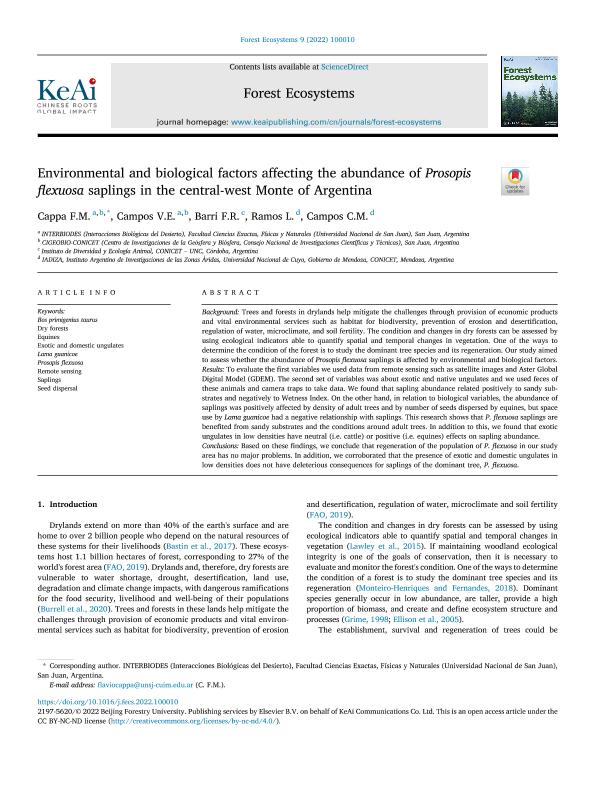Mostrar el registro sencillo del ítem
dc.contributor.author
Cappa, Flavio Martín

dc.contributor.author
Campos, Valeria Evelin

dc.contributor.author
Barri, Fernando Rafael

dc.contributor.author
Ramos, Liliana Cecilia

dc.contributor.author
Campos, Claudia Monica

dc.date.available
2023-08-30T15:45:01Z
dc.date.issued
2022-12
dc.identifier.citation
Cappa, Flavio Martín; Campos, Valeria Evelin; Barri, Fernando Rafael; Ramos, Liliana Cecilia; Campos, Claudia Monica; Environmental and biological factors affecting the abundance of Prosopis flexuosa saplings in the central-west Monte of Argentina; Elsevier; Forest Ecosystems; 9; 12-2022; 1-8
dc.identifier.issn
2197-5620
dc.identifier.uri
http://hdl.handle.net/11336/209935
dc.description.abstract
Background: Trees and forests in drylands help mitigate the challenges through provision of economic products and vital environmental services such as habitat for biodiversity, prevention of erosion and desertification, regulation of water, microclimate, and soil fertility. The condition and changes in dry forests can be assessed by using ecological indicators able to quantify spatial and temporal changes in vegetation. One of the ways to determine the condition of the forest is to study the dominant tree species and its regeneration. Our study aimed to assess whether the abundance of Prosopis flexuosa saplings is affected by environmental and biological factors. Results: To evaluate the first variables we used data from remote sensing such as satellite images and Aster Global Digital Model (GDEM). The second set of variables was about exotic and native ungulates and we used feces of these animals and camera traps to take data. We found that sapling abundance related positively to sandy substrates and negatively to Wetness Index. On the other hand, in relation to biological variables, the abundance of saplings was positively affected by density of adult trees and by number of seeds dispersed by equines, but space use by Lama guanicoe had a negative relationship with saplings. This research shows that P. flexuosa saplings are benefited from sandy substrates and the conditions around adult trees. In addition to this, we found that exotic ungulates in low densities have neutral (i.e. cattle) or positive (i.e. equines) effects on sapling abundance. Conclusions: Based on these findings, we conclude that regeneration of the population of P. flexuosa in our study area has no major problems. In addition, we corroborated that the presence of exotic and domestic ungulates in low densities does not have deleterious consequences for saplings of the dominant tree, P. flexuosa.
dc.format
application/pdf
dc.language.iso
eng
dc.publisher
Elsevier

dc.rights
info:eu-repo/semantics/openAccess
dc.rights.uri
https://creativecommons.org/licenses/by-nc-nd/2.5/ar/
dc.subject
BOS PRIMIGENIUS TAURUS
dc.subject
DRY FORESTS
dc.subject
EQUINES
dc.subject
EXOTIC AND DOMESTIC UNGULATES
dc.subject
LAMA GUANICOE
dc.subject
PROSOPIS FLEXUOSA
dc.subject
REMOTE SENSING
dc.subject
SAPLINGS
dc.subject
SEED DISPERSAL
dc.subject.classification
Ecología

dc.subject.classification
Ciencias Biológicas

dc.subject.classification
CIENCIAS NATURALES Y EXACTAS

dc.title
Environmental and biological factors affecting the abundance of Prosopis flexuosa saplings in the central-west Monte of Argentina
dc.type
info:eu-repo/semantics/article
dc.type
info:ar-repo/semantics/artículo
dc.type
info:eu-repo/semantics/publishedVersion
dc.date.updated
2023-07-04T14:22:19Z
dc.journal.volume
9
dc.journal.pagination
1-8
dc.journal.pais
Países Bajos

dc.journal.ciudad
Ámsterdam
dc.description.fil
Fil: Cappa, Flavio Martín. Consejo Nacional de Investigaciones Científicas y Técnicas. Centro Científico Tecnológico Conicet - San Juan. Centro de Investigaciones de la Geosfera y Biosfera. Universidad Nacional de San Juan. Facultad de Ciencias Exactas Físicas y Naturales. Centro de Investigaciones de la Geosfera y Biosfera; Argentina. Universidad Nacional de San Juan. Facultad de Ciencias Exactas Físicas y Naturales. Departamento de Biología; Argentina
dc.description.fil
Fil: Campos, Valeria Evelin. Consejo Nacional de Investigaciones Científicas y Técnicas. Centro Científico Tecnológico Conicet - San Juan. Centro de Investigaciones de la Geosfera y Biosfera. Universidad Nacional de San Juan. Facultad de Ciencias Exactas Físicas y Naturales. Centro de Investigaciones de la Geosfera y Biosfera; Argentina. Universidad Nacional de San Juan. Facultad de Ciencias Exactas Físicas y Naturales. Departamento de Biología; Argentina
dc.description.fil
Fil: Barri, Fernando Rafael. Consejo Nacional de Investigaciones Científicas y Técnicas. Centro Científico Tecnológico Conicet - Córdoba. Instituto de Diversidad y Ecología Animal. Universidad Nacional de Córdoba. Facultad de Ciencias Exactas Físicas y Naturales. Instituto de Diversidad y Ecología Animal; Argentina
dc.description.fil
Fil: Ramos, Liliana Cecilia. Consejo Nacional de Investigaciones Científicas y Técnicas. Centro Científico Tecnológico Conicet - Mendoza. Instituto Argentino de Investigaciones de las Zonas Áridas. Provincia de Mendoza. Instituto Argentino de Investigaciones de las Zonas Áridas. Universidad Nacional de Cuyo. Instituto Argentino de Investigaciones de las Zonas Áridas; Argentina
dc.description.fil
Fil: Campos, Claudia Monica. Consejo Nacional de Investigaciones Científicas y Técnicas. Centro Científico Tecnológico Conicet - Mendoza. Instituto Argentino de Investigaciones de las Zonas Áridas. Provincia de Mendoza. Instituto Argentino de Investigaciones de las Zonas Áridas. Universidad Nacional de Cuyo. Instituto Argentino de Investigaciones de las Zonas Áridas; Argentina
dc.journal.title
Forest Ecosystems
dc.relation.alternativeid
info:eu-repo/semantics/altIdentifier/url/https://linkinghub.elsevier.com/retrieve/pii/S2197562022000100
dc.relation.alternativeid
info:eu-repo/semantics/altIdentifier/doi/http://dx.doi.org/10.1016/j.fecs.2022.100010
Archivos asociados
